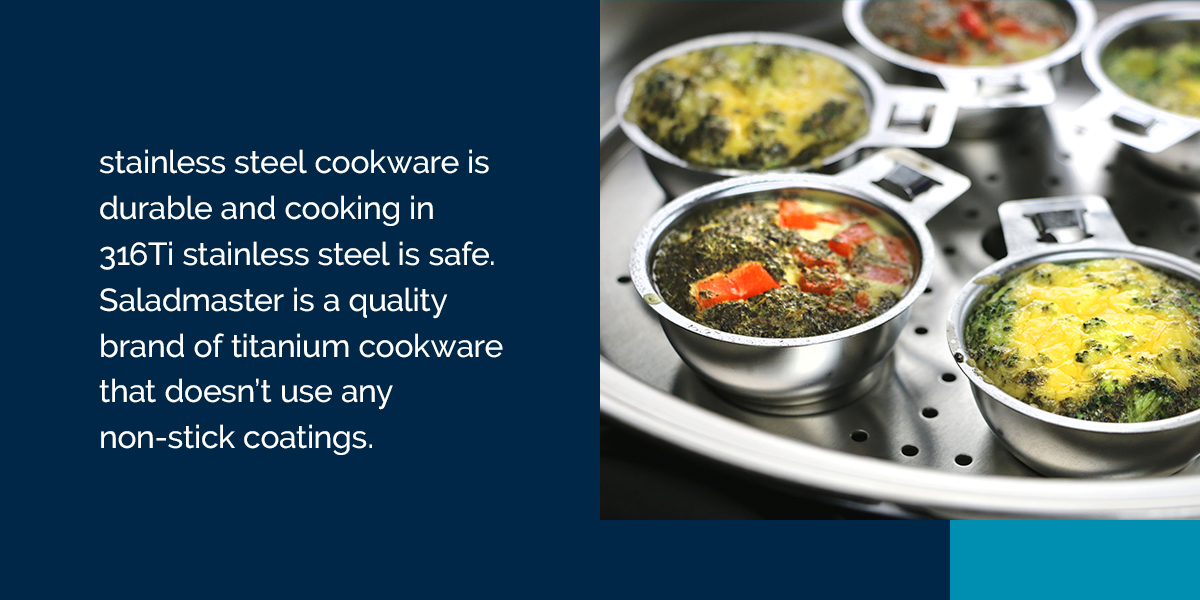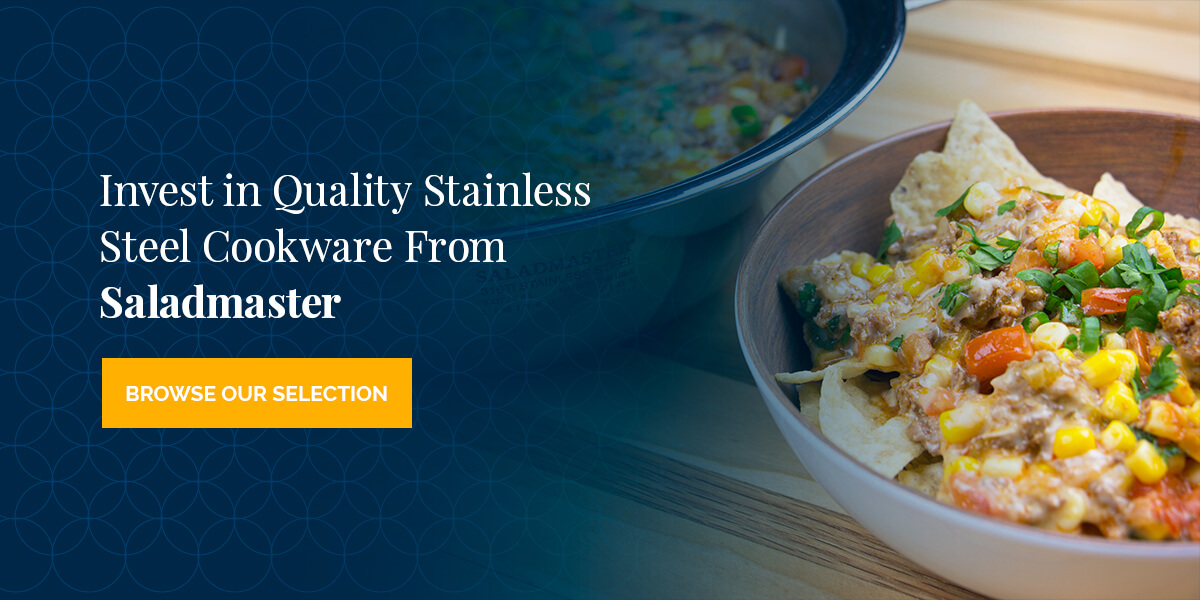Health Benefits of Stainless Steel Cookware
Investing in durable, high-quality cookware is essential when you spend a lot of time in the kitchen preparing your meals. If you’re still using the non-stick pans you started cooking with, it’s likely time to switch to a more substantial cookware material. Stainless steel is sturdy and long-lasting, requires little maintenance and boasts a modern aesthetic appeal, making it an excellent choice for your cooking needs.
If you’ve never used stainless steel cookware, you may have some questions. We’ve compiled this guide to cooking with stainless steel to take you through the benefits, from its healthier cooking surface to its surprisingly easy clean-up. Read on to discover more about these benefits and learn about this impressive material.
What Is the Best Type of Stainless Steel Cookware?
Before digging into the health benefits of stainless steel, it’s important to get clear on what type we’re talking about. With multiple stainless steel alloys available with different strengths and weaknesses, some grades are more effective for cookware than others. Some are magnetic, while others enhance corrosion resistance. Here are some examples:
- 304: This grade is austenitic and nonmagnetic. You’ll commonly find it in food preparation equipment like sinks and ice chests. While its corrosion resistance makes it a solid choice for many kitchen appliances, exposure to salt can cause it to corrode. You may also want something more reliable if you’re working in a high-temperature environment.
- 316: 316 stainless steel is also austenitic and nonmagnetic. It’s often referred to as “food grade” due to its high anti-corrosion properties. When working with more corrosive foods, this is the grade for you. It’s more costly than 304, but the added expense is worth it since it holds up far longer against these stressors.
- 430: This grade is ferritic with minimal nickel content, meaning its corrosion resistance is vastly lower. Because 430 is far less durable than austenitic grades, it’s better for decorative purposes and moderately corrosive environments.
- 443: 443 is another ferritic magnetic grade. While its corrosion and temperature resistances are similar to 304, it’s not as durable as either austenitic grade.
Because they’re austenitic and specially designed for wear resistance, 304 and 316 are the two most common stainless steel grades in cookware. While both are known for their high tensile strength and impressive maximum operating temperature, the main differentiator is their chemical composition.
304’s alloy composition primarily contains chromium and nickel, along with slight traces of manganese and carbon. Although 316Ti — a titanium-stabilized variation of alloy 316 — uses similar amounts of chromium and nickel, it also adds molybdenum and titanium to the mix. While stainless steel can corrode, reinforcing 316 stainless steel with titanium makes it more resistant to general corrosion and pitting corrosion than 304. It also increases its tolerance to elevated cooking temperatures.
316Ti cookware is your best bet if you want the strongest and longest-lasting choice. In addition to its incredible rust resistance, 316Ti stainless steel cookware has other benefits that make it a worthy addition to your kitchen, which we’ll explore in the next couple of sections.
Is 316Ti Stainless Steel Cookware Safe to Cook With?
316Ti stainless steel is a highly durable, top-quality metal that doesn’t emit toxins or react with ingredients, making it the safest option for cooking in your home. From its incredible rust resistance to its ease of cleaning, this cookware has numerous benefits that make it a worthy addition to your kitchen.

No Harmful Non-Stick Chemical Coatings
Most non-stick pans are made with aluminum and coated with a non-stick material like Teflon or polyfluoroalkyl substances (PFAS). We don’t recommend pans with these coatings as they can be potentially harmful. While Teflon isn’t considered toxic on its own, it may be a cause for concern when it gets too hot.
When the pan overheats, the Teflon coating generally starts to disintegrate and release toxic gases as it breaks down. In rare cases, breathing in these fumes may lead to polymer fume fever, characterized by shortness of breath and a high fever. Teflon pans also release perfluorooctanoic acid (PFOA) as they heat up. Long-term PFOA exposure is linked to cancer, thyroid disease and other conditions.
In addition to potential health concerns, cookware with non-stick chemical coatings is more challenging to use and maintain. Since high heat will break down their delicate coating, most non-stick pans aren’t oven safe. Therefore, you can’t brown or sear foods with high heat like you can with 316Ti stainless steel cookware.
You also can’t use sharp or metal utensils like spatulas, whisks and spoons with non-stick pans as they will scratch and break down the coating. Once they deteriorate, you need to discard them right away so the non-stick chemical coating won’t flake into your food.
However, stainless steel cookware is durable and cooking in 316Ti stainless steel is safe. Saladmaster is a quality brand of titanium cookware that doesn’t use any non-stick coatings. You might try cooking with low heat methods like Saladmaster’s Vapo-Valve technology. This waterless semi-vacuum cookware includes a built-in valve that clicks when your food reaches optimal cooking temperature. This way, you’ll know when to lower the heat to avoid overcooking.
Easy to Clean and Sanitize
Stainless steel cookware is easy to clean and disinfect. It’s non-porous with a smooth and sealed surface that air and liquid cannot move through. Since food can’t penetrate the surface, it’s easy to prevent buildup that would lead to the growth of germs and bacteria.
In comparison, more porous cookware materials like aluminum and copper can expand under heat. Food can stick to the pan as it expands, making it harder to clean. When you invest in high-quality 316Ti stainless steel cookware from Saladmaster, keeping it clean is a breeze.
Stainless steel cookware is dishwasher-safe, so you can stick to this cleaning method if desired. However, when you have some food bits that won’t budge, you may want to tackle it yourself. Here are some tips to keep in mind when you want to clean your pan thoroughly by hand:
- Choose a proper tool: Cleaning utensils like steel wool brushes are too abrasive for stainless steel. They often shed iron particles, and metal flakes on the cookware’s surface can lead to rust formation. Some better alternatives are non-abrasive sponges, gentle brushes and soft cloths.
- Scrub your cookware: Scrub your stainless steel pan with your choice of cleaning tool and hot soapy water. If stuck-on food pieces remain, fill the cookware with enough soapy water to cover the residue. You can also add a few spoonfuls of baking soda for extra cleaning power. Bring the water to a boil, then scrape away the remaining food with a wooden spoon or spatula. The residue should scrape off easily. Let the pan cool, then wash and dry as usual.
- Disinfect: You can also disinfect your pan after washing. It’s generally best to avoid bleach or chlorine-based cleaners as these can damage the stainless steel’s surface. Everyday products like disinfecting wipes and sprays are usually safer for this material. However, it’s essential to thoroughly rinse the steel’s surface with fresh water after using one of these sprays or wipes. The residue may be abrasive to stainless steel if you leave it on the surface for an extended period.
- Dry: Wipe the cookware dry with a clean, soft cloth to avoid water spots and maintain its shine.

Invest in Quality Stainless Steel Cookware From Saladmaster
As you can see, stainless steel is a superior, safe and healthy material for cooking. That’s why we offer high-quality stainless steel cookware at Saladmaster!
Because we carefully construct our cookware with premium 316Ti stainless steel, it doesn’t react to the enzymes and acids in food. The steel combines with our semi-vacuum Vapo-Valve technology to protect the flavor and purity of your ingredients, letting you have a nutritious, flavorful meal every time you cook.
Invest in safe, high-quality cookware from our selection. Browse stainless steel cookware from Saladmaster today. You can also visit our recipe center if you need ideas for healthy and delicious meals the whole family will enjoy!
24341